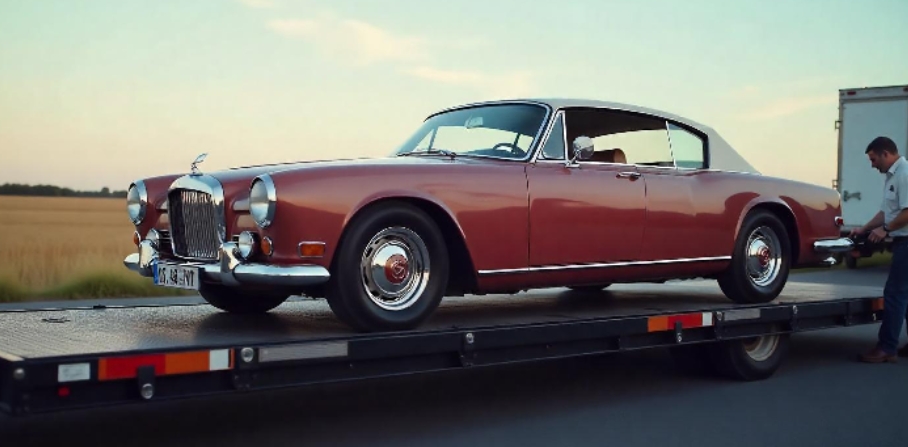Safe and Secure: Car Towing Tips for High-End and Classic Cars

Strong 8k brings an ultra-HD IPTV experience to your living room and your pocket.
When it comes to transporting high-end luxury vehicles or classic collector cars, towing is not just about getting from point A to point B. These prized automobiles are more than just modes of transportation—they're investments, heirlooms, and in many cases, irreplaceable pieces of automotive history. Improper towing can lead to damage, devaluation, or even legal issues. That’s why a meticulous, safety-first approach is crucial.
Whether you’re relocating, attending a car show, or shipping a vehicle to a buyer, here’s your comprehensive guide to safe and secure car towing for high-end and classic vehicles, especially when it involves car towing from state to state.
Why Special Care Is Needed for High-End and Classic Cars
Luxury and classic vehicles require extra attention for a few key reasons:
- Unique Build and Materials: Classic cars may have delicate original parts or outdated materials that aren’t compatible with modern towing techniques.
- Low Ground Clearance: Sports and luxury cars often have very low profiles, making them more vulnerable during loading and unloading.
- High Value: Beyond monetary worth, these vehicles often carry significant sentimental or historical value.
- Insurance and Liability Risks: Damage caused during towing can lead to complex insurance claims and disputes.
1. Choose the Right Type of Tow Truck
The first and most critical decision is choosing the correct towing method. Not all towing options are suitable for high-value vehicles, especially if you're planning car towing from state to state.
Flatbed Towing (Recommended)
A flatbed truck lifts the entire vehicle off the ground and secures it on a flat platform. It’s the safest option for luxury or classic cars.
Benefits:
- Minimizes risk of body or undercarriage damage
- Prevents wear and tear on tires and drivetrain
- No contact with road debris or potholes
Enclosed Towing (Premium Protection)
Enclosed trailers provide full coverage from the elements, road debris, and prying eyes.
Ideal for:
- Cross-country or long-distance towing
- Ultra-high-value vehicles
- Rare classic cars or showpieces
This method is especially valuable for car towing from state to state, where exposure to unpredictable weather and road conditions is a concern.
2. Vet the Towing Company Carefully
Not all towing companies are equipped to handle premium cars. Here’s what to look for:
Key Considerations:
- Specialization in Exotic or Classic Cars: Check if they have experience with brands like Ferrari, Rolls-Royce, or vintage Mustangs.
- Reviews and References: Read verified car towing reviews or ask for references from classic car clubs or dealerships.
- Insurance Coverage: Make sure they have adequate cargo insurance and are willing to provide a certificate upon request.
- Proper Equipment: Ask if they use soft straps, winches, wheel nets, and low-angle loading ramps.
If you're arranging car towing from state to state, vetting becomes even more critical because long-distance towing involves more risk and requires tighter logistical planning.
3. Prepare the Vehicle for Safe Towing
Interior and Exterior Preparation
- Remove all valuables and custom accessories (e.g., GPS, audio systems)
- Secure or remove loose parts (spoilers, mirrors, antennae)
- Take high-resolution photos of the vehicle from all angles as proof of condition
Mechanical Prep
- Ensure tires are properly inflated
- Turn off alarms or immobilizers
- Check for leaks that may cause issues during transit
- Ensure the battery is charged if loading via winch is required
These preparation steps are essential, especially when coordinating car towing from state to state, where multiple handlers or route transitions might occur.
4. Use Proper Strapping Techniques
Improper strapping is one of the leading causes of towing-related damage.
Best Practices:
- Use soft nylon straps or wheel nets—never chain directly to the chassis or axle
- Secure all four wheels to distribute tension evenly
- Ensure straps are tight but not over-torqued to avoid body distortion
- Recheck straps during long hauls for tightness due to vibration or shifting
For longer journeys, such as vehicle towing from state to state, checking and double-checking strap tension becomes even more critical during stops and driver changes.
5. Be Mindful of Weather Conditions
Weather can significantly affect towing conditions, especially for long-distance trips.
Cold Weather
- Road salt can corrode undercarriages. Opt for enclosed transport.
- Allow longer travel times to avoid rushing and risking damage
Hot Weather
- High heat can affect tire pressure and mechanical components
- Cover any exposed leather or vinyl interiors to prevent sun damage
When arranging auto towing from state to state, weather considerations are vital since the vehicle may pass through multiple climate zones.
6. Understand Insurance and Liability Coverage
Before handing over your keys, double-check your insurance and that of the towing provider.
Ask These Questions:
- Does my insurance cover towing-related damages?
- Does the tow company’s insurance cover the full replacement value of my car?
- What happens in the event of mechanical damage during loading/unloading?
For vehicle towing from state to state, it's advisable to have both local and long-distance insurance protections in place to ensure full coverage across jurisdictions.
7. Consider GPS Tracking for Peace of Mind
Some high-end towing companies offer real-time auto GPS tracking for their vehicles and loads. This can:
- Provide real-time updates on location and ETA
- Offer additional security during cross-country or overnight moves
- Serve as proof of route in case of disputes or claims
Tracking is especially helpful for car towing from state to state, allowing owners to monitor progress in real time.
8. Plan the Route and Timing
Avoiding high-traffic areas, rough terrain, and extreme weather zones is key. Work with your towing provider to plan the safest route possible, especially if:
- You're attending a car show or auction with a strict deadline
- You're towing through regions with seasonal hazards (snow, storms, etc.)
Route planning is essential for car towing from state to state, ensuring optimal timing and minimizing risk during longer hauls.
9. What to Do During and After the Tow
During transport, stay in contact with the driver and check-in if possible. Once the vehicle arrives:
Post-Tow Checklist:
- Inspect the car immediately for dents, scratches, or misalignment
- Compare condition against pre-tow photos and inspection report
- Test drive (if possible) to ensure mechanical integrity
- Report any damage immediately to the towing company and your insurer
Conclusion
Luxury and classic cars deserve the utmost care—on the road and off it. Whether you're relocating, attending a car show, or coordinating car towing from state to state, following the right steps can prevent costly mistakes and give you peace of mind.
Remember: when it comes to high-end vehicle towing, it’s not just about getting the job done—it’s about doing it right.
Note: IndiBlogHub features both user-submitted and editorial content. We do not verify third-party contributions. Read our Disclaimer and Privacy Policyfor details.







